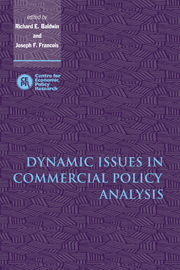Book contents
- Frontmatter
- Contents
- List of figures
- List of tables
- Preface
- List of conference participants
- 1 Introduction
- 2 Transition dynamics and trade policy reform in developing countries
- 3 Putting growth effects in computable equilibrium trade models
- 4 Innovation, capital accumulation, and economic transition
- 5 Multinational production, skilled labour, and real wages
- 6 Economic policy and the manufacturing base: hysteresis in location
- 7 Trade liberalization and investment in a multilateral framework
- 8 Investment creation and investment diversion: simulation analysis of the Single Market programme
- 9 Blueprints, spillovers, and the dynamic gains from trade liberalization in a small open economy
- 10 Trade policy and North–South migration
- 11 Long-term modelling of trade and environmental linkages
- 12 Labour markets and dynamic comparative advantage
- Index
12 - Labour markets and dynamic comparative advantage
Published online by Cambridge University Press: 13 January 2010
- Frontmatter
- Contents
- List of figures
- List of tables
- Preface
- List of conference participants
- 1 Introduction
- 2 Transition dynamics and trade policy reform in developing countries
- 3 Putting growth effects in computable equilibrium trade models
- 4 Innovation, capital accumulation, and economic transition
- 5 Multinational production, skilled labour, and real wages
- 6 Economic policy and the manufacturing base: hysteresis in location
- 7 Trade liberalization and investment in a multilateral framework
- 8 Investment creation and investment diversion: simulation analysis of the Single Market programme
- 9 Blueprints, spillovers, and the dynamic gains from trade liberalization in a small open economy
- 10 Trade policy and North–South migration
- 11 Long-term modelling of trade and environmental linkages
- 12 Labour markets and dynamic comparative advantage
- Index
Summary
Introduction
Although international migration has received more public attention because of its complex political implications, domestic migration is often of greater historical significance, both numerically and economically. While in some countries like the United States, the first type is a necessary condition for the second, the latter still deserves attention in its own right. Patterns of domestic migration have dramatically influenced both internal economic structure and trade orientation in many nations. This has often followed a two-stage process, where migration into the hinterland to develop the primary resource base is succeeded by migration to the cities seeking opportunity in the modern sector. Such demographic trends can influence and be influenced by shifting trade orientation; i.e. changes in the composition of human resources have important implications for dynamic comparative advantage, and terms-of-trade changes can exert significant pressure on domestic labour markets.
The magnitudes of this kind of population adjustment can truly be impressive. In the nineteenth century, Latin America was about 15 per cent urban, and the figure now is 90 per cent. Indonesia expects its total population to grow modestly, from 180 million in 1990 to about 240 million by 2040, but at the same time the urban population is projected to grow from 24 per cent to 65 per cent. China's population, while still predominantly rural, is experiencing strong migratory pressures. According to official estimates, some 100 million Chinese are currently classified as migrants, while officials at the Chinese Academy of Social Sciences estimate (conservatively) a labour surplus in agriculture of about 250 million.
- Type
- Chapter
- Information
- Dynamic Issues in Commercial Policy Analysis , pp. 367 - 378Publisher: Cambridge University PressPrint publication year: 1999



